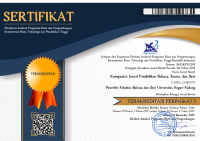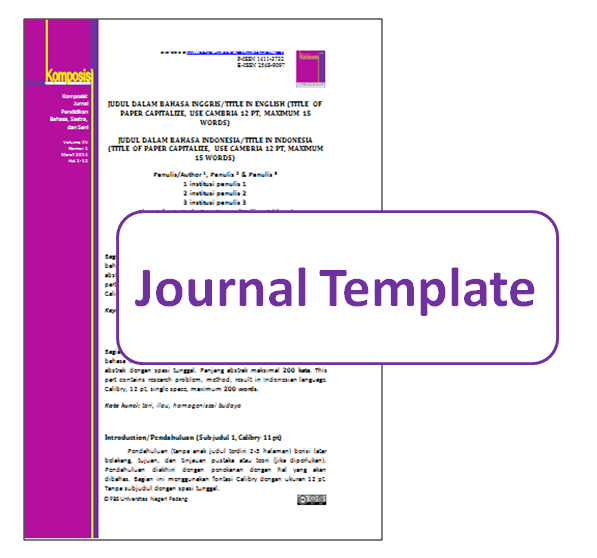DESIGNING AN ENGLISH FOR NUTRITIONISTS AND DIETITIANS’ CURRICULUM: A RESEARCH BY ADDIE APPROACH
Abstract
Keywords
Full Text:
PDFReferences
Anh, P. (2015). "Applying Group Work Activities to Improve English Speaking Skills for Nursing Students at Danang University of Medical TECHNOLOGY and Pharmacy." The University of Danang - Journal of Science and Technology, no. 1, 2015, pp. 94-99.
Arifai, A., (2019). "Pengembangan Kurikulum Masa Depan." Raudhah Proud To Be Professionals, vol. 4, no. 2, 17 Dec. 2019, pp. 11-26, doi:10.48094/raudhah.v4i2.45.
Arroyyani, R., Widiyati, D. & Maryani,. (2022). A Need Analysis of ESP for Public Health Students. ESTEEM: Journal of English Study Programme. 5. 161-171.
Basturkmen, H. (2010). Developing Courses in English for Specific Purposes. doi:10.1057/9780230290518
Budiyanto, M., (2020). "Curriculum as a Dynamic System." JournalNX, vol. 6, no. 08, 2020, pp. 10-18.
Dalle, M., Halijah, S. & Hadijah. (2018). "The Role of ESP in Fostering EFL Students' English Competence." Tamaddun, vol. 17, no. 2, 31 Dec. 2018, pp. 35-39, doi:10.33096/tamaddun.v17i2.11.
Halimah, S., (2019). "Strategi Pengembangan Kurikulum Dan Pembelajaran Pendidikan Agama Islam (Pai)." Miqot, vol. 33, no. 1, 2009, doi:10.30821/miqot.v33i1.178.
Hasnawan, D., (2021). "Need Analysis of English For Engineering Students: A Case Study." Journal of English Language Learning, vol. 5, no. 1, 2021, doi:10.31949/jell.v5i1.3167.
Kay, K. (2011). Framework for 21st Century Learning. Retrieved from http://p21.org/documents/1.__p21_framework_2-pager.pdf
Latief, M., (2012). Research Method on Language Learning: An Introduction. Malang: UM Press
Lodhi, M., Shamim, M., Robab, M., Shahzad, S., & Ashraf, A. (2018). English for Doctors: An ESP Approach to Needs Analysis and Course Design For Medical Students. International Journal of English Linguistics. 8. 205. 10.5539/ijel.v8n5p205.
Mentari, D., (2013). "Model Desain Sistem Pembelajaran Analysis, Design, Development, Implementation, Evaluation (Addie) Sebagai Upaya Meningkatkan Hasil Belajar Siswa Pada Mata Diklat Stenografi." Jurnal Pendidikan Administrasi Perkantoran Universitas Sebelas Maret, vol. 2, no. 1, Jun. 2013.
Reeves, T. (2000). Enhancing the worth of instructional technology research through “design experiments” and other developmental strategies. Retrieved from http://it.coe.uga.edu/~treeves/AERA2000Reeves.pdf
Richard, J., (2013). Curriculum Approaches in Language Teaching. Forward, Central, and Backward Design RELC Journal. 2013.44 (1)
Ritonga, J., (2016). "Designing Curriculum, Capacity of Innovation, and Performances: a Study on the Pesantrens in North Sumatra." Miqot, vol. 40, no. 1, 2016, doi:10.30821/miqot.v40i1.216
Rover, D., (2006). Engineering Education: Research and Development in Curriculum and Instruction: By John Heywood. Journal of Engineering Education, 95(3), 255–256. doi:10.1002/j.2168-9830.2006.tb00898.x
Sasabone, L., & Pongpalilu, F., (2022) Improving Students’ Reading Comprehension of English for Specific Purposes (ESP) at UKI Paulus Makassar. EDULEC : EDUCATION, LANGUAGE AND CULTURE JOURNAL, 2(1), 87–93. https://doi.org/10.56314/edulec.v2i1.30
Setiyadi, B., Revyta, & Fadhilah, A., (2020). "Prinsip-prinsip Pengembangan Kurikulum." Khazanah Pendidikan, vol. 14, no. 1, 2 Sep. 2020, doi:10.30595/jkp.v14i1.8473.
Sharma, & Sharma (2016). An Article on Developing Relevant Curriculum an Article on Developing Relevant Curriculum. Daffodil International University Journal of Science and Technology. 10. 186-192.
Suwandi, Edi & Wafa., (2020). Developing English Syllabus for Pharmacy Students. IDEAS: Journal on English Language Teaching and Learning, Linguistics and Literature. 8. 426-434. 10.24256/ideas.v8i2.1598.
Thijs, A., & Van D., (Eds.). (2009). Curriculum in development. Enschede, Netherlands: SLO–Netherlands Institute for Curriculum Development. Retrieved from http://www.slo.nl/downloads/2009/curriculum-in-development.pdf/
Wademan, M. (2005). Utilizing development research to guide people capability maturity model adoption considerations. Unpublished doctoral dissertation, Syracuse University. (New York, USA)
DOI: https://doi.org/10.24036/komposisi.v23i2.119682
Refbacks
- There are currently no refbacks.
Copyright (c) 2022 Komposisi: Jurnal Pendidikan Bahasa, Sastra, dan Seni

This work is licensed under a Creative Commons Attribution-NonCommercial 4.0 International License.
Komposisi: Jurnal Pendidikan Bahasa, Sastra, dan Seni, a peer-reviewed online journal in languages, literature, and arts education.
Printed ISSN 1411-3732, Online ISSN 2548-9097.
Currently, Komposisi: Jurnal Pendidikan Bahasa, Sastra, dan Seni is indexed by:
Published by:
Universitas Negeri Padang (UNP)
Address: Faculty of Languages and Arts (FBS) Universitas Negeri Padang.
Jl Prof. Dr. Hamka Air Tawar Barat, Padang - West Sumatera -Indonesia
Telp/Fax. +62751 7053363
Home page: http://ejournal.unp.ac.id/index.php/komposisi | e-mail:komposisi.fbsunp @ fbs.unp.ac.id | cc: havid_a @ fbs.unp.ac.id
slot resmi
situs toto
situs toto toto slot
Wanita Subang Beli mobil dari Nolimit city
Gatot kaca Buat TKW Jadi jutawan
Rahasia sukses bermain Mahjing wins
rahasia sukses bermain mahjong ways
div>












